GamerDad Unplugged: Highlights of GenCon 2015
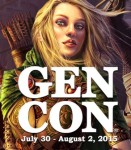 I visited GenCon last week, one of the largest gaming conventions in the U.S. 60,000+ people mobbed downtown Indianapolis for the four days of the event. All types of games were covered including boardgames, roleplaying games, and collectible card games. I have an entire series covering many games in detail over at OpinionatedGamers. I have a rundown of dice games, more complex games, family games, children’s games, and a mix of roleplaying and “everything else.”
I visited GenCon last week, one of the largest gaming conventions in the U.S. 60,000+ people mobbed downtown Indianapolis for the four days of the event. All types of games were covered including boardgames, roleplaying games, and collectible card games. I have an entire series covering many games in detail over at OpinionatedGamers. I have a rundown of dice games, more complex games, family games, children’s games, and a mix of roleplaying and “everything else.”
However, to save everyone some time, I’ve dug out some of my favorite games of the convention so you don’t necessarily have to wade through all my reports (unless you want to see some of the variety at the convention.)
First, a bunch of cool games for families with slightly older kids (middle school or particularly bright elementary.) With the kids (and fun-loving adults) games to follow.
Catan Traveller Edition
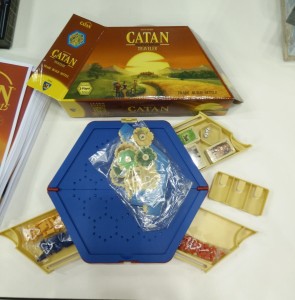 Catan Traveller Edition t is slightly more compact than the Travel Box, this edition comes with a foldable plastic hexagonal case that keeps all the components safely within it. Pieces and cards fit snuggly into the drawers on the side of the hexagon. (Note that the pieces don’t slip into pegs like the Travel Box, so it doesn’t work as well on bumpy rides.)
Catan Traveller Edition t is slightly more compact than the Travel Box, this edition comes with a foldable plastic hexagonal case that keeps all the components safely within it. Pieces and cards fit snuggly into the drawers on the side of the hexagon. (Note that the pieces don’t slip into pegs like the Travel Box, so it doesn’t work as well on bumpy rides.)
Mtg Arena of Planeswalkers
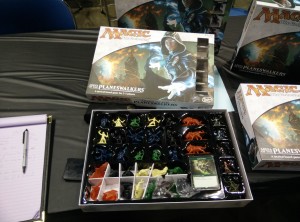 Magic the Gathering: Arena of the Planeswalkers is designed by the people who did Heroscape, one of the greatest kid-friendly combat miniature games ever. That is a fine pedigree for me to hope it will go over with my two young boys. It is promising so far. The base game has a leader (painted) and two army troops (3 units per troop, all unpainted) for each color of Magic (white, red, green, blue, black) so it technically could be played with up to 5 players (although I suspect it would get crowded on the cardboard tiles that serve as the board.) On a turn, a player can either activate their planeswalker or one of their squads. A planeswalker will either move and attack or summon another squad. Combat is very Heroscape-like with line of sight, terrain (mostly rivers), and a bit of elevation (the game only has a few Heroscape-compatible hexagon tiles.) New to this game are the spells available to each player. They fit the themes common to each color of the Magic: the Gathering game. Spells are played on one’s turn and have an instant effect or they’re played face down and are then used to respond to something on another player’s turn. There will be “rune” like tokens in some scenarios (there are suggested ones or you can just mash things together) that grant abilities to your army as long as you occupy them. The game has expansions (not collectible/randomized, thank goodness) as well, planned for early 2016. One of the intents of the game was to introduce new players to the Magic: the Gathering game. I think it succeeds in giving gamers the flavor of the game, with its spells and unique color-themed powers, but it is still a big jump over to the full fledged card game. It doesn’t matter to me, as I expect to get plenty of use out of the boardgame with my sons.
Magic the Gathering: Arena of the Planeswalkers is designed by the people who did Heroscape, one of the greatest kid-friendly combat miniature games ever. That is a fine pedigree for me to hope it will go over with my two young boys. It is promising so far. The base game has a leader (painted) and two army troops (3 units per troop, all unpainted) for each color of Magic (white, red, green, blue, black) so it technically could be played with up to 5 players (although I suspect it would get crowded on the cardboard tiles that serve as the board.) On a turn, a player can either activate their planeswalker or one of their squads. A planeswalker will either move and attack or summon another squad. Combat is very Heroscape-like with line of sight, terrain (mostly rivers), and a bit of elevation (the game only has a few Heroscape-compatible hexagon tiles.) New to this game are the spells available to each player. They fit the themes common to each color of the Magic: the Gathering game. Spells are played on one’s turn and have an instant effect or they’re played face down and are then used to respond to something on another player’s turn. There will be “rune” like tokens in some scenarios (there are suggested ones or you can just mash things together) that grant abilities to your army as long as you occupy them. The game has expansions (not collectible/randomized, thank goodness) as well, planned for early 2016. One of the intents of the game was to introduce new players to the Magic: the Gathering game. I think it succeeds in giving gamers the flavor of the game, with its spells and unique color-themed powers, but it is still a big jump over to the full fledged card game. It doesn’t matter to me, as I expect to get plenty of use out of the boardgame with my sons.
Dice City
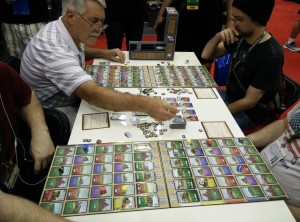 In Dice City (2-4p), players roll five dice (one of each color) and place them on the designated spot on a 5×6 grid (one spot for every possible roll.) One one’s turn one can then remove dice to accomplish different actions, such as removing a die to activate the ability on that particular location. Other options include discarding a die to move another die left or right one space, refresh 4 of the 8 central location (building) cards to look for more options, reactivate a closed building, or simply gain a pass token (1/turn limit.) Two pass tokens can be exchanged for 1 resource, +1 strength (in combat) for a turn, or to force an opponent to reroll one of their dice. The second phase of the game players can use strength to attack bandits (gain VP), attack other players (to close a location), or attack other players to steal 1 resource. A player then uses all their resources (1 of each type can be saved) to build one of the 8 showing locations (which replace one’s default spots on one’s board), or build trade ships (for VP.) Rinse and repeat until the location deck is spent, one player completes (upgrades) two complete rows on their board, 2 of the trade ship stacks are gone, or all of the bandit stacks are gone.
In Dice City (2-4p), players roll five dice (one of each color) and place them on the designated spot on a 5×6 grid (one spot for every possible roll.) One one’s turn one can then remove dice to accomplish different actions, such as removing a die to activate the ability on that particular location. Other options include discarding a die to move another die left or right one space, refresh 4 of the 8 central location (building) cards to look for more options, reactivate a closed building, or simply gain a pass token (1/turn limit.) Two pass tokens can be exchanged for 1 resource, +1 strength (in combat) for a turn, or to force an opponent to reroll one of their dice. The second phase of the game players can use strength to attack bandits (gain VP), attack other players (to close a location), or attack other players to steal 1 resource. A player then uses all their resources (1 of each type can be saved) to build one of the 8 showing locations (which replace one’s default spots on one’s board), or build trade ships (for VP.) Rinse and repeat until the location deck is spent, one player completes (upgrades) two complete rows on their board, 2 of the trade ship stacks are gone, or all of the bandit stacks are gone.
Star Trek Five Year Mission
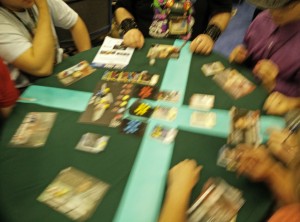 Mayfair is releasing a cooperative game (everyone is wins or loses together) called Star Trek Five Year Mission. A 3-7 player game, each player is given a character from Star Trek universe (classic or next gen) with unique powers. Players draw missions from three decks (easy to hard) and then try to complete them by matching appropriate rolls of their dice. Failures can damage players, removing one of their dice (which may be healed later.) Some missions are considered “Prime Directives” which have to be completed before any others. Only 3 missions of each difficulty can be present, if a fourth is drawn it damages the ship (forcing players to pull from the more difficult missions in the future.) Completing some missions scores points. A wide range of difficulties is available; beginners need to score 10 points (at least one of each color), while those wanting a harder game can play for 19 points (and at least 2 of each color mission.)
Mayfair is releasing a cooperative game (everyone is wins or loses together) called Star Trek Five Year Mission. A 3-7 player game, each player is given a character from Star Trek universe (classic or next gen) with unique powers. Players draw missions from three decks (easy to hard) and then try to complete them by matching appropriate rolls of their dice. Failures can damage players, removing one of their dice (which may be healed later.) Some missions are considered “Prime Directives” which have to be completed before any others. Only 3 missions of each difficulty can be present, if a fourth is drawn it damages the ship (forcing players to pull from the more difficult missions in the future.) Completing some missions scores points. A wide range of difficulties is available; beginners need to score 10 points (at least one of each color), while those wanting a harder game can play for 19 points (and at least 2 of each color mission.)
Flip City
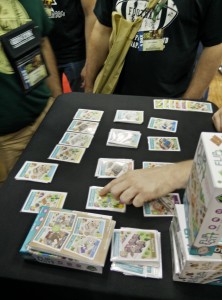 The new Flip City is a 1-4 player deckbuilder game. Deckbuilding games are where players have a stack of cards and slowly add to their deck (reshuffling when needed so that the new cards get shuffled in.) In Flip City, players don’t have a hand of cards, they simply flip up the top card of their deck until they wish to stop (if they are allowed – some bad cards make you keep going and can spoil your plans.) The money revealed is used to buy new cards or upgrade ones you already own (in your discard.) Upgrading is easy since each card (there are only six types) is double sided and you simply upgrade to the other side. Some cards have frowny-faces and if you draw too many (three I think) your turn ends without getting to spend your money. If you are able to get victory points showing on your played cards (or play 18 cards if you have a special building) you win the game. I’ve enjoyed playing it with my middle-elementary son, he easily took to the game (without any deckbuilder experience – it may help that you don’t have to decide what to do with a hand of cards.) So far, I like how it has only a few cards but teaches some of the basic ideas of a deckbuilder game… the only drawback for this purpose (fewer cards) is its slightly longer game length (30-50 minutes, but it falls on the shorter side with 2 players.)
The new Flip City is a 1-4 player deckbuilder game. Deckbuilding games are where players have a stack of cards and slowly add to their deck (reshuffling when needed so that the new cards get shuffled in.) In Flip City, players don’t have a hand of cards, they simply flip up the top card of their deck until they wish to stop (if they are allowed – some bad cards make you keep going and can spoil your plans.) The money revealed is used to buy new cards or upgrade ones you already own (in your discard.) Upgrading is easy since each card (there are only six types) is double sided and you simply upgrade to the other side. Some cards have frowny-faces and if you draw too many (three I think) your turn ends without getting to spend your money. If you are able to get victory points showing on your played cards (or play 18 cards if you have a special building) you win the game. I’ve enjoyed playing it with my middle-elementary son, he easily took to the game (without any deckbuilder experience – it may help that you don’t have to decide what to do with a hand of cards.) So far, I like how it has only a few cards but teaches some of the basic ideas of a deckbuilder game… the only drawback for this purpose (fewer cards) is its slightly longer game length (30-50 minutes, but it falls on the shorter side with 2 players.)
Pocket Imperium
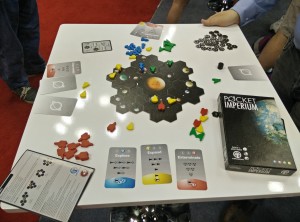 Coming out in two weeks is the fast-playing, 2-4 player Pocket Imperium that should play in about 30-45 minutes. One of several games at the convention relying on the simultaneous selection of action cards. The game board consists of a central hexagon surrounded by one ring of hexagons. Players attempt to place ships onto the planets on the board (some hexagons have multiple planets, some are empty space) in order to score points for each occupied planet. Each player chooses one hexagon to score that round, with the player controlling the center picking an additional location. The game provides a player with three options each round: Expand, Explore, and Exterminate. Expand puts ships on the board at already occupied locations, Explore allows ships to move, and Exterminate allows players to invade and destroy opponent ships at a 1:1 ratio. Thus, attacking 1 ship with 2 of your own will leave you the winner with 1 ship left. Players secretly select their actions and then reveal. The catch is that playing a unique action provides better results. Action cards are compared to your neighbors and lose one utility for each match. Playing expand when your neighbors do not, nets you a cool 3 ships to place. If all three of you play Expand you get a lonely 1 ship. After all the actions are played in order (Expand, Explore, Exterminate) ship upkeep occurs (Exploit) where players can only have 1 more ship present than the planet supports (so empty space supplies a single ship.) After six rounds (2-3p) or eight rounds (4p) the game ends. I like a fast 4X type of game, so am interested, but don’t see it coming out much as a 2 player game.
Coming out in two weeks is the fast-playing, 2-4 player Pocket Imperium that should play in about 30-45 minutes. One of several games at the convention relying on the simultaneous selection of action cards. The game board consists of a central hexagon surrounded by one ring of hexagons. Players attempt to place ships onto the planets on the board (some hexagons have multiple planets, some are empty space) in order to score points for each occupied planet. Each player chooses one hexagon to score that round, with the player controlling the center picking an additional location. The game provides a player with three options each round: Expand, Explore, and Exterminate. Expand puts ships on the board at already occupied locations, Explore allows ships to move, and Exterminate allows players to invade and destroy opponent ships at a 1:1 ratio. Thus, attacking 1 ship with 2 of your own will leave you the winner with 1 ship left. Players secretly select their actions and then reveal. The catch is that playing a unique action provides better results. Action cards are compared to your neighbors and lose one utility for each match. Playing expand when your neighbors do not, nets you a cool 3 ships to place. If all three of you play Expand you get a lonely 1 ship. After all the actions are played in order (Expand, Explore, Exterminate) ship upkeep occurs (Exploit) where players can only have 1 more ship present than the planet supports (so empty space supplies a single ship.) After six rounds (2-3p) or eight rounds (4p) the game ends. I like a fast 4X type of game, so am interested, but don’t see it coming out much as a 2 player game.
There were a couple interesting role playing games that I found. While Dungeons and Dragons had a moderate presence (it’s now in the 5th edition, which is a pretty good one,) I like to find the more odd and obscure ones to check out.
ICONS RPG
![]() ICONS is a superhero role playing game with pretty simple rules, so gamers can focus more on the story than on combat (always a danger with superheros – combat can get complex and slow.) Aside from its easier play, one of its more interesting aspects is its randomly generated characters. You roll on a few charts to find out your background and your powers. (I’m sure you could just pick your own, but the world of superheroes is rife with characters who had no choice in their powers…) The main book is ICONS: the Assembled Edition which gives you all you need to play, although I learned there is another supplement ICONS: Great Power with a few more ways to look at powers. If you’re curious, you can even pay what you want to purchase the slightly older version of the game.
ICONS is a superhero role playing game with pretty simple rules, so gamers can focus more on the story than on combat (always a danger with superheros – combat can get complex and slow.) Aside from its easier play, one of its more interesting aspects is its randomly generated characters. You roll on a few charts to find out your background and your powers. (I’m sure you could just pick your own, but the world of superheroes is rife with characters who had no choice in their powers…) The main book is ICONS: the Assembled Edition which gives you all you need to play, although I learned there is another supplement ICONS: Great Power with a few more ways to look at powers. If you’re curious, you can even pay what you want to purchase the slightly older version of the game.
Catthulhu RPG
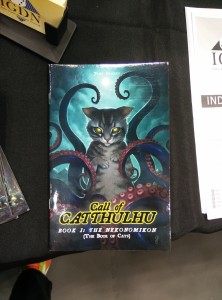 Catthulhu also caught my eye, partly due to the title and cover, and partly because of the cute cat dice they were selling with the game (not necessary for play, though.) Players are cats trying to destroy the many cults of the other animals. Designed for 2-6 players, the GM (Cat Herder) plays the other animals and characters each have their own cat with different breeds essentially the different character classes available. It uses a d6 system where 2 sides are “sad” and the other 4 sides are “happy” and you count up the happy & sad markers when you make your rolls.
Catthulhu also caught my eye, partly due to the title and cover, and partly because of the cute cat dice they were selling with the game (not necessary for play, though.) Players are cats trying to destroy the many cults of the other animals. Designed for 2-6 players, the GM (Cat Herder) plays the other animals and characters each have their own cat with different breeds essentially the different character classes available. It uses a d6 system where 2 sides are “sad” and the other 4 sides are “happy” and you count up the happy & sad markers when you make your rolls.
While many people cover the “hot new boardgames” for more gamer-y adults, I also like to see the types of games that would go over well with families with younger kids (and adults who aren’t above a bit of silly, but entertaining! games. You won’t find a Candyland (and it’s complete lack of any decision-making) in this bunch.
Monster Laundry
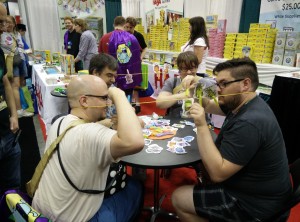 HABA always comes through with some great, solid kid’s games. Monster Laundry was another silly game I spotted at the convention. Players sit in a circle and envelop themselves in a large loop of stretchy clothesline (note they have it around their neck in the photo, I’m told it’s easier if it loops around under your arms.) Players then race to pick up their particular color of monster, putting star spotted monsters on one side and the circle spotted ones on their other side. In the second round, players remove their monsters and attempt to clip up one of each other color, with special grey ones in the middle usable as jokers. It looked to be a solid 2-5p “silly game” for when such a game is required.
HABA always comes through with some great, solid kid’s games. Monster Laundry was another silly game I spotted at the convention. Players sit in a circle and envelop themselves in a large loop of stretchy clothesline (note they have it around their neck in the photo, I’m told it’s easier if it loops around under your arms.) Players then race to pick up their particular color of monster, putting star spotted monsters on one side and the circle spotted ones on their other side. In the second round, players remove their monsters and attempt to clip up one of each other color, with special grey ones in the middle usable as jokers. It looked to be a solid 2-5p “silly game” for when such a game is required.
Lift It Deluxe
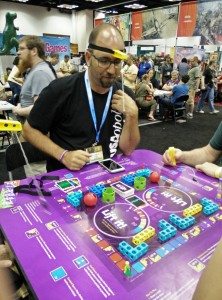 Lift It Deluxe displays a bunch of nice blocks full of holes. Players flip over a card, and then have 40 seconds to use a little “crane” with a hook to build the structure displayed on the card. Each piece in the right place is worth 1 point, and a bonus 4 points is awarded for completing the object (not very easy.) Players move around a player board with their tokens, and some locations force the player to use the crane affixed to their forehead instead. Alternatively, do what the demo players were doing and just do all of them off their head. It looked like a fun dexterity game for a family game night where not everyone wants a lot of strategy to their game.
Lift It Deluxe displays a bunch of nice blocks full of holes. Players flip over a card, and then have 40 seconds to use a little “crane” with a hook to build the structure displayed on the card. Each piece in the right place is worth 1 point, and a bonus 4 points is awarded for completing the object (not very easy.) Players move around a player board with their tokens, and some locations force the player to use the crane affixed to their forehead instead. Alternatively, do what the demo players were doing and just do all of them off their head. It looked like a fun dexterity game for a family game night where not everyone wants a lot of strategy to their game.
Mars Attacks: 10 minute takedown
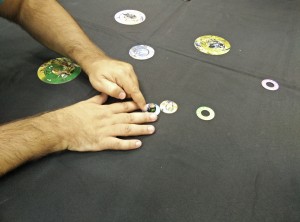 The game that drew me into the Steve Jackson Games booth was Mars Attacks: 10 Minute takedown. It is essentially a flicking game where players take turns trying to flick a die so that it lands on one of the central target rings. Players place a die inside their marker ring and then flick it towards a target. The marker ring is then moved to surround the die in its new location and the die is passed to the next player. Landing a die on one of the rings grants a player the outermost ring of that set, providing points (more for the smaller rings) and sending that player back to their starting position. Landing on another player’s ring scores nothing but does send them back to their start. The dice comes into play when landing on the rings. If the top face of the die matches the symbol on that set of rings, a player scores an extra point. The game continues until all the rings are claimed. Since the more valuable rings are claimed last, it helps to keep losing players in the game. While accuracy is important, I could see that better players were able to increase their odds of landing on the correct die face as well.
The game that drew me into the Steve Jackson Games booth was Mars Attacks: 10 Minute takedown. It is essentially a flicking game where players take turns trying to flick a die so that it lands on one of the central target rings. Players place a die inside their marker ring and then flick it towards a target. The marker ring is then moved to surround the die in its new location and the die is passed to the next player. Landing a die on one of the rings grants a player the outermost ring of that set, providing points (more for the smaller rings) and sending that player back to their starting position. Landing on another player’s ring scores nothing but does send them back to their start. The dice comes into play when landing on the rings. If the top face of the die matches the symbol on that set of rings, a player scores an extra point. The game continues until all the rings are claimed. Since the more valuable rings are claimed last, it helps to keep losing players in the game. While accuracy is important, I could see that better players were able to increase their odds of landing on the correct die face as well.
Pie Face
Pie Face, from Hasbro, is way out in left field. Apparently this is a “thing” in Europe, going somewhat viral on YouTube with Scottish grandfather and grandson. You take a physical little plastic hand in the middle and fill it with actual whipped cream. Players take turns leaning their face into an upright loop, and then and ratcheting up the mechanism. It is a total Russian Roulette situation with the pie flipping up into the player’s face at a randomized time…. I can definitely see this used in several party game situations.
Flick em Up
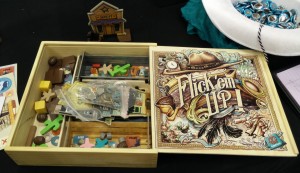 Flick ‘em Up! caught my eye right away as it is a ficking carom game with a strong theme. Most carom games have a fairly pasted on theme (if any) so a wild western duel had a strong attraction. Players each take a generously sized cowboy token and place him in a wild west town represented by thin wooden “town buildings”. Players are essentially involved in a duel where the active player places a round carom token on the table and attempts to flick it so that it hits their opponent. Characters usually have health points that reduce when hit and are knocked out of the game when they run out. Aside from a shootout, the game has different scenarios that can be played, including the use of the buildings. Shoot a carom under a building (there’s a small slot there) and you are treated as being “in” that building. Opponents need to also flick into that building in order to start a duel. Rated at 2-10 players (there are 10 main character tokens), the game works well for lots of players on teams, although 10 sounds like it could get a bit long, unless everyone is pretty good at their trash talking. There is now an expansion coming out in a few months. It adds in horses, a canyon, and female figures. Figures can “tame” the horses and then ride them (getting two shots per turn instead of one) using standard flicking mechanisms. The game is not cheap, due to the nice wooden pieces – and it comes in a wooden box – but it is quite a fun game.
Flick ‘em Up! caught my eye right away as it is a ficking carom game with a strong theme. Most carom games have a fairly pasted on theme (if any) so a wild western duel had a strong attraction. Players each take a generously sized cowboy token and place him in a wild west town represented by thin wooden “town buildings”. Players are essentially involved in a duel where the active player places a round carom token on the table and attempts to flick it so that it hits their opponent. Characters usually have health points that reduce when hit and are knocked out of the game when they run out. Aside from a shootout, the game has different scenarios that can be played, including the use of the buildings. Shoot a carom under a building (there’s a small slot there) and you are treated as being “in” that building. Opponents need to also flick into that building in order to start a duel. Rated at 2-10 players (there are 10 main character tokens), the game works well for lots of players on teams, although 10 sounds like it could get a bit long, unless everyone is pretty good at their trash talking. There is now an expansion coming out in a few months. It adds in horses, a canyon, and female figures. Figures can “tame” the horses and then ride them (getting two shots per turn instead of one) using standard flicking mechanisms. The game is not cheap, due to the nice wooden pieces – and it comes in a wooden box – but it is quite a fun game.
Chopstick dexterity mega challenge 3000
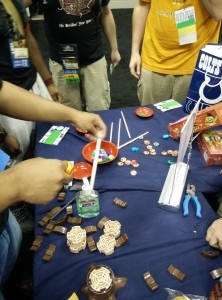 Mayday Games can always be counted on for some interesting kid’s games. This GenCon was no exception. Heading up the field was Chopstick Dexterity Mega Challenge 3000. I already own an old copy of Chopstick Dexterity Mega Challenge 3000, but I was happy to see Chopstick Dexterity Mega Challenge 3000 being reprinted. The game comes with 3 sets of chopsticks and a central bowl full of sushi-like wooden pieces. A token is flipped up representing a specific wooden piece in the bowl. Players then compete to remove that piece and place it in their personal bowl. A few tokens are “grey” which indicate all the pieces of that color are up for grabs. If you have the most points after the tokens are all flipped, you have won Chopstick Dexterity Mega Challenge 3000. Note that you can play Chopstick Dexterity Mega Challenge 3000 in a friendly way where the focus is on being the first to grab the item, or you may play the Dark Side of the game where almost everything is legal and knocking pieces out opponents sticks is highly encouraged… be sure to decide your path before you start…
Mayday Games can always be counted on for some interesting kid’s games. This GenCon was no exception. Heading up the field was Chopstick Dexterity Mega Challenge 3000. I already own an old copy of Chopstick Dexterity Mega Challenge 3000, but I was happy to see Chopstick Dexterity Mega Challenge 3000 being reprinted. The game comes with 3 sets of chopsticks and a central bowl full of sushi-like wooden pieces. A token is flipped up representing a specific wooden piece in the bowl. Players then compete to remove that piece and place it in their personal bowl. A few tokens are “grey” which indicate all the pieces of that color are up for grabs. If you have the most points after the tokens are all flipped, you have won Chopstick Dexterity Mega Challenge 3000. Note that you can play Chopstick Dexterity Mega Challenge 3000 in a friendly way where the focus is on being the first to grab the item, or you may play the Dark Side of the game where almost everything is legal and knocking pieces out opponents sticks is highly encouraged… be sure to decide your path before you start…
Pingo Pingo
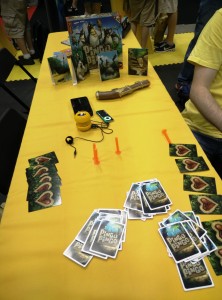 At the Iello booth I first sat down to a game of Pingo Pingo. Who can resist a game with little stand up cards and a plastic dart launching pirate pistol? A bit like slapjack, players take turns flipping over their cards one at a time. Some cards require a player to complete an action (shoot a target, run around the room touching both ends of the bridge, etc…) while others require players to be the first to slap down on the card. Slap the attacking Pingo Tribe and you get to distribute the pile of cards to the other players. Slap a Camp card and you get to steal two of the other player’s treasures, etc… As one would expect, there are “fake” cards (a treasure card vs a treasure card with spiders on it for instance) around that will cause damage to a player when slapping them. To make things more confusing, there is a soundtrack that calls out when Day changes over to Night and vice versa. Many of the cards come in both day and night forms, so be sure to slap only the correct ones. The soundtrack is also used as a “hot potato” penalty timer, doing damage to the active player. Looks pretty goofy with a bit of running around that might also work for older gamers wanting a silly change as well.
At the Iello booth I first sat down to a game of Pingo Pingo. Who can resist a game with little stand up cards and a plastic dart launching pirate pistol? A bit like slapjack, players take turns flipping over their cards one at a time. Some cards require a player to complete an action (shoot a target, run around the room touching both ends of the bridge, etc…) while others require players to be the first to slap down on the card. Slap the attacking Pingo Tribe and you get to distribute the pile of cards to the other players. Slap a Camp card and you get to steal two of the other player’s treasures, etc… As one would expect, there are “fake” cards (a treasure card vs a treasure card with spiders on it for instance) around that will cause damage to a player when slapping them. To make things more confusing, there is a soundtrack that calls out when Day changes over to Night and vice versa. Many of the cards come in both day and night forms, so be sure to slap only the correct ones. The soundtrack is also used as a “hot potato” penalty timer, doing damage to the active player. Looks pretty goofy with a bit of running around that might also work for older gamers wanting a silly change as well.
That’s a small sample of all the games I saw, but were ones I thought stood out from the pack. There were other great ones, some a bit more complex, so feel free to go over to my articles on the OpinionatedGamers site if you want to read about them all!





August 11th, 2015 at 7:19 pm
Hello, thank you for your comments about my game. You can find on the FB page https://www.facebook.com/monsterpropre
and on this blog http://monsterpropre.wix.com/monster-propre-haba
several variants and pledges to renew the play and add fun to your party.
Monsters regards, Rémy-lee